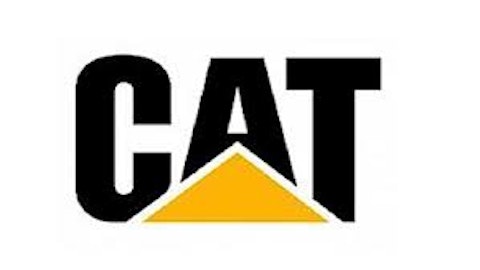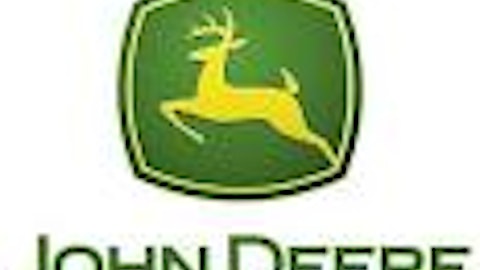Only time will tell the difference between a fad and a trend. Similarly, brands’ enduring power is measured in decades and centuries instead of days. Deere & Company (NYSE:DE), the largest manufacturer of agricultural equipment globally with a history spanning more than a century, bears testimony to that.
Why this company enjoys pricing power

Firstly, brand building takes a tremendous amount of time and effort. The Deere & Company (NYSE:DE) brand has the advantage of time over its competitors and new entrants, with a legacy extending 175 years back to 1837. Similar to how Coca-Cola is synonymous with coke, Deere & Company (NYSE:DE)’s products have been the de facto choice for farmers when it comes to agricultural equipment.
Secondly, the nature of farming suggests that the harvesting period might be short, but nothing should go wrong during that period. Any downtime associated with the usage of inferior equipment is totally unacceptable for the farmers. Deere & Company (NYSE:DE)’s extensive network of dealer locations provide its customers with convenient access to repair and maintenance services for their equipment.
Operational efficiency edge should not be ignored
It is easy to focus on competitive advantages and growth prospects, and ignore the importance of operational efficiency in running a profitable business.
Many fast growing companies, in terms of revenues, end up reporting losses or lackluster profits because they are simply spending more to generate sales. In contrast, Deere & Company (NYSE:DE) has consistently worked on enhancing its productivity. It increased its net sales per employee by almost five times over a span of three decades, from $100,000 in 1982 to $500,000 in 2012.
Working capital efficiency is another critical component of operational excellence, with increasing receivables relative to sales being a red flag for many investors. Deere managed to raise receivables turnover from 5.8 in fiscal 2003 to 10.2 in fiscal 2012, essentially doubling the amount of sales with the same level of receivables.
Cash is king only if shareholders are rewarded
Deere generated positive cash flows from operations in every single year in the past decade, and has historically rewarded shareholders with the excess cash flow in the form of dividends and share buybacks.
Since 2004, it has repurchased about 164 billion shares at a total cost of $6.4 billion. The fact that the historical average repurchase price of $57.70 is well below the current share price in the mid-80s, speaks well about the value-accretive nature of the buybacks. As of the end of April, Deere still has about $2.2 billion remaining from its 2008 share repurchase authorization, implying room for further capital return.
Deere also has an uninterrupted dividend payment track record since 1997, and has a target payout ratio representing 25%-35% of mid-cycle earnings. It currently sports a decent 2.4% dividend yield.
Future outlook
Deere delivered record quarterly revenues and earnings in the second quarter of fiscal 2013. Net sales and operating profit from equipment operations rose by 9.0% and 9.3% year-on-year to approximately $10.9 billion and $1.7 billion, respectively. Management is guiding for a 5% and 8% year-on-year growth in full year fiscal 2013 equipment sales and net income on the back of secular trends pertaining to global food and infrastructure demand.
Looking ahead, international expansion and new products sales are key growth initiatives. Its operations outside the U.S. and Canada still account for less half of total sales; while Deere has put a higher emphasis on research & development, with R&D as a percent of sales rising from about 2.0% in 2000 to above 5.5% in 2012.
Peer comparison
Deere’s peers include Caterpillar Inc. (NYSE:CAT) and AGCO Corporation (NYSE:AGCO).
Caterpillar Inc. (NYSE:CAT) is one of the largest manufacturers of construction and mining equipment globally. Its profit per share for the first quarter fell by 45% year-on-year to $1.31 as a result of weak economic growth affecting end-user demand and production. In view of this, management revised the mid-point of its full year fiscal 2013 earnings outlook from $8.00 per share to $7.00 per share.
Similar to Deere, Caterpillar Inc. (NYSE:CAT)’s strong brand names and extensive dealer network have been contributing factors for its success. However, its expansion into mining equipment sales have increased Caterpillar Inc. (NYSE:CAT)’s exposure to the volatility of global commodity prices. Its mining business accounted for about 17% of its fiscal 2012 revenues. Reduced demand for Caterpillar Inc. (NYSE:CAT)’s mining equipment are the likely consequences of depressed commodity prices and lower mining capital expenditure.
AGCO Corporation (NYSE:AGCO) is a manufacturer of agricultural machinery such as tractors, hay tools, sprayers, grain storage & protein production systems and replacement parts. It distributes its products through more than 3,000 dealers in over 140 countries globally, under its five flagship brands: Challenger, Fendt, Massey Ferguson, Valtra and GSI.
AGCO Corporation (NYSE:AGCO)’s results for the first quarter were unsatisfactory with quarterly earnings per share down from $1.21 a year ago to $1.19. Going forward, management guided for full year 2013 earnings per share to grow to a range of $5.50 – $5.70 from $5.30 in 2012.
I am negative on ACGO, given its concentration of revenues in Western Europe, representing about half of its total sales. Farmers in Europe have been deferring their investments in new agricultural equipment in view of the weak macro environment.
Conclusion
I like Deere for its consistent gross margins, strong operational efficiency and shareholder friendly capital return policies. At 11 times forward P/E and 0.9 times PEG, Deere is attractively valued and warrants a buy in my book.
The article Is This Century Old Company of Choice For Both Farmers and Investors? originally appeared on Fool.com.
Mark Lin has no position in any stocks mentioned. The Motley Fool has no position in any of the stocks mentioned. Mark is a member of The Motley Fool Blog Network — entries represent the personal opinion of the blogger and are not formally edited.
Copyright © 1995 – 2013 The Motley Fool, LLC. All rights reserved. The Motley Fool has a disclosure policy.

